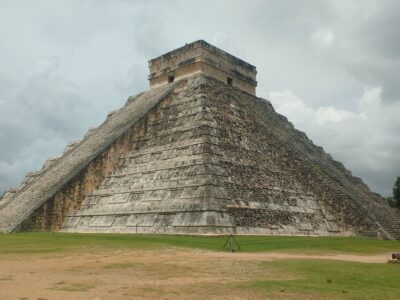The Yucatecan flag, a symbol of identity and pride for the inhabitants of the state of Yucatan, has a rich and fascinating history that is intertwined with the historical events that marked the future of the peninsula.
This regional emblem not only represents the cultural wealth and historical heritage of Yucatan but also the struggle and desires of its inhabitants throughout time.
Historical context
The Trigarante flag of Mexico meant union and harmony to represent the army of Agustín de Iturbide when the country’s independence was achieved, back in 1821. The first stripe symbolized the purity of the Catholic religion and was white; the second stripe was green and symbolized the ideal of Mexican independence and the autonomy of the government; the third stripe was red and represented the ideal of the union of blood between Indigenous people, mestizos, creoles and Spaniards; and the stars represented the three guarantees and the will to fulfill them. These same ideals were taken up by the Yucatecans to fight against authoritarian centralism.
The Yucatecan flag was raised on the Mérida City Hall building, in the “Plaza Grande” of the capital of the state of Yucatán, for the first and only time, on March 16, 1841, as a protest against the centralism of Antonio López de Santa Anna. The banner was never again used officially by the authorities of Yucatán after 1848.
Regarding the historical flag of the Republic of Yucatán, Rodolfo Menéndez de la Peña, historian, described it as follows:
The Yucatecan flag was divided into two fields: on the left, one green, and on the right, another with three divisions, red, above and below, and white in the middle. On the green field or canvas of the flag, five stars stood out, symbolizing the five departments into which Yucatan was divided by the Decree of November 30, 1840, these were: Mérida, Izamal, Valladolid, Tekax, and Campeche.
Due to disagreements between Mexico and the United States, the Texan ship commander Edwin W. Moore asked the governor of Yucatan, Santiago Méndez Ibarra, to carry this banner as a symbol so as not to be attacked. On April 26, 1842, the governor declared that the only flag that Yucatan had was that of the Mexican Republic. The poet Ricardo Mimenza Castillo wrote the following verse about the Yucatecan flag:
It was a flag divided into two planes; one green with its five stars, thus faith and hope united. The red, of valor, alternates with the white in their quarrels in the background… What epics, saw the once-favorite flag! The noble Don Miguel Barbachano raised that insignia in his robust hand; he defended it in his campaigns, where the blood bounced dry. It was the old Yucatecan flag, of a hundred battles …
Ricardo Mimenza Castillo
After several negotiations with the Mexican government, through Andrés Quintana Roo and after overcoming the problems and differences with the metropolis, the social classes of Yucatan asked for the reincorporation of the peninsula into the Mexican confederation. The historian Lanz comments that on August 17, 1848, Governor Miguel Barbachano issued the decree of reincorporation to Mexico.
Background
The origin of the Yucatecan flag dates back to the times of the Caste War (1847-1901), a conflict that had profound implications for the Yucatan peninsula. This war pitted the indigenous Mayan people against the mestizos and criollos and was a period of intense struggle for control and autonomy of the region.
During this period, the feeling of identity and belonging was strengthened among the Yucatecans, leading them to search for symbols that represented their resistance and desire for autonomy.
Design and meaning
The Yucatecan flag is composed of five horizontal stripes of equal size, alternating green and white, with a red canton in the upper left corner containing five white five-pointed stars.
Green and White Stripes: The green stripes represent hope and the natural wealth of the region, while the white ones symbolize peace and unity among the Yucatecans.
Red Canton and White Stars: The red canton with the five stars symbolizes the five departments into which Yucatan was divided during the 19th century: Mérida, Valladolid, Izamal, Tekax, and Campeche. The red color represents the bravery and blood shed by those who fought for the freedom and autonomy of Yucatan.
The Republic of Yucatan
One of the most notable moments in the history of the Yucatecan flag was during the proclamation of the Republic of Yucatan. In 1841, due to political and economic differences with the Mexican central government, Yucatan declared its independence and established itself as a sovereign republic. During this period (1841-1848), the flag was used as the official symbol of the independent state.
Reinstated to the Federation
In 1848, Yucatán was reintegrated into the Mexican Republic, but the Yucatecan flag did not disappear. Over the years, it has continued to be a symbol of regional identity, used in various ceremonies and cultural events. Although it does not have an official status as the flag of the state of Yucatán, it remains a beloved and respected emblem for the Yucatecans.
Current meaning
Today, although this flag that was used during the Republic of Yucatán in the 19th century does not have official validity, the Yucatecan population uses it at its discretion to express its Yucatan identity. In 2001, a commemoration was held in the city of Mérida for the 160th anniversary of its first and last official use.
On October 12, 2022, after having been used 181 years ago, the flag of Yucatán was flown again in the Mexican Senate.
In addition, the Yucatecan flag is a reminder of the resilient spirit and rich cultural heritage of Yucatán. It can be seen waving at cultural, sporting, and official events, reminding the inhabitants of the peninsula, their history, and their shared identity. It is a symbol of pride and the unity of a people who have known how to preserve their culture and traditions over time.
At the initial proposal of Yucatecan senators, and after approval by both chambers of the Congress of the Union, as well as by more than half of the state legislatures, on May 8, 2023, a reform to article 116 of the Political Constitution of the United Mexican States was published in the Official Gazette of the Federation, so that the Mexican States are empowered as federative entities capable to legislate on their state symbols, including anthems, flags and shields, to promote history, cultural heritage and local identity. This, in the case of the state of Yucatan, has not yet occurred.
As a result of this constitutional reform, on August 21, 2023, the Executive of the Government of the State of Yucatan waved the historic flag of the Republic of Yucatan again, after 182 years, in a protocolary act, with the presence of the heads of the Legislative and Judicial powers. However, the fact of raising the flag does not yet give it the status of the official flag of the federative entity in legal terms, as long as the Congress of the State of Yucatan does not issue the corresponding law that regulates it.
The Yucatecan flag is more than a simple emblem; it is a testimony of the history, the struggle, and the spirit of a people who deeply value their identity and their heritage. It represents the beauty, the natural wealth, and the courage of the Yucatecans, and remains a symbol of pride for present and future generations.
TYT Newsroom
The post The epic origin of the Yucatecan flag first appeared on The Yucatan Times.














